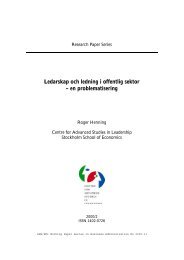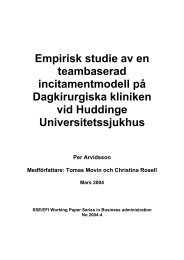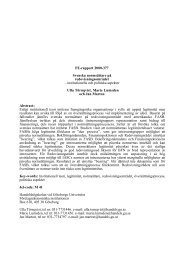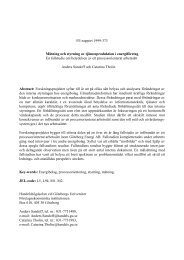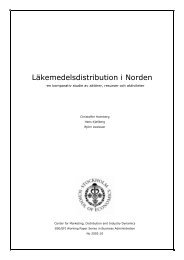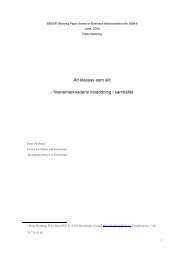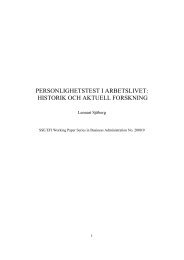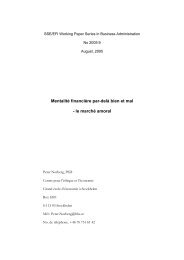Big Five Plus - S-WoBA - Handelshögskolan i Stockholm
Big Five Plus - S-WoBA - Handelshögskolan i Stockholm
Big Five Plus - S-WoBA - Handelshögskolan i Stockholm
You also want an ePaper? Increase the reach of your titles
YUMPU automatically turns print PDFs into web optimized ePapers that Google loves.
43. Costa, P. T., & McCrae, R. R. (1977). Age differences in personality structure revisited:<br />
Studies in validity, stability, and change. International Journal of Aging & Human<br />
Development, 8(4), 261-275.<br />
44. Costa, P. T., & McCrae, R. R. (2003). NEO PI-R. Manual, svensk version av Hans Bergman.<br />
<strong>Stockholm</strong>: Psykologiförlaget.<br />
45. Couch, A., & Keniston, K. (1961). Agreeing response set and social desirability. The<br />
Journal of Abnormal and Social Psychology, 62(1), 175-179.<br />
46. Crawford, J. R., & Henry, J. D. (2004). The Positive and Negative Affect Schedule (PA-<br />
NAS): Construct validity, measurement properties and normative data in a large nonclinical<br />
sample. British Journal of Clinical Psychology, 43(3), 245-265.<br />
47. Crowne, D. P., & Marlowe, D. (1960). A new scale of social desirability independent of<br />
psychopathology. Journal of Consulting and Clinical Psychology, 24, 349-354.<br />
48. d'Andrade, R. B. (1965). Trait psychology and componential analysis. American Anthropologist,<br />
67, 215-218.<br />
49. De Raad, B., & Perugini, M. (2005). <strong>Big</strong> <strong>Five</strong> factor assessment: Introduction. In B. De<br />
Raad & M. Perugini (Eds.), <strong>Big</strong> <strong>Five</strong> assessment (pp. 1-26). Seattle: Hogrefe & Huber.<br />
50. Dean, M. A., Conte, J. M., & Blankenhorn, T. R. (2006). Examination of the predictive<br />
validity of <strong>Big</strong> <strong>Five</strong> personality dimensions across training performance criteria. Personality<br />
and Individual Differences, 41(7), 1229-1239.<br />
51. DeYoung, C. G., Quilty, L. C., & Peterson, J. B. (2007). Between facets and domains: 10<br />
aspects of the <strong>Big</strong> <strong>Five</strong>. Journal of Personality and Social Psychology, 93(5), 880-896.<br />
52. Dickson, D. H., & Kelly, I. W. (1985). The 'Barnum Effect' in personality assessment: A<br />
review of the literature. Psychological Reports, 57, 367-382.<br />
53. Digman, J. M. (1997). Higher-order factors of the <strong>Big</strong> <strong>Five</strong>. Journal of Personality and<br />
Social Psychology, 73(6), 1246-1256.<br />
54. Digman, J. M., & Wiggins, J. S. (1996). The curious history of the five-factor model. In J.<br />
S. Wiggins (Ed.), The five-factor model of personality: Theoretical perspectives (pp.<br />
1-20). New York: Guilford Press.<br />
55. Donnellan, M. B., Oswald, F. L., Baird, B. M., & Lucas, R. E. (2006). The Mini-IPIP Scales:<br />
Tiny-Yet-Effective Measures of the <strong>Big</strong> <strong>Five</strong> Factors of Personality. Psychological<br />
Assessment, 18(2), 192-203.<br />
56. Duckworth, A. L., Peterson, C., Matthews, M. D., & Kelly, D. R. (2007). Grit: Perseverance<br />
and passion for long-term goals. Journal of Personality and Social Psychology,<br />
92(6), 1087-1101.<br />
57. Dudley, N. M., Orvis, K. A., Lebiecki, J. E., & Cortina, J. M. (2006). A Meta-Analytic<br />
Investigation of Conscientiousness in the Prediction of Job Performance: Examining<br />
154



